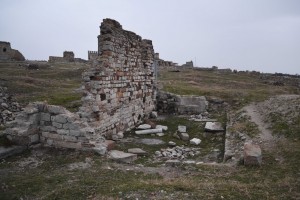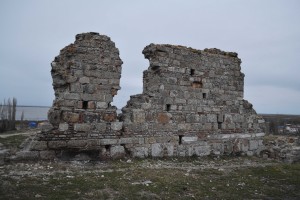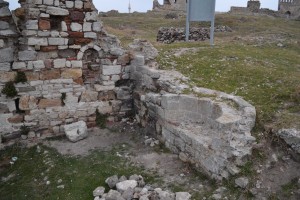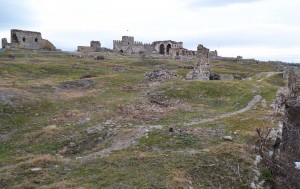Archive for February 19th, 2016
This tiny single-naved building is located in the northern part of the citadel at Enez. It was intact until the early 20th century (apart from the narthex) but now exists as a floor plan and a single wall on the north-eastern side. It was intact in the early 20th century and a photograph taken by Georgios Lambakis shows it to have been a simple tile-roofed building, much the shape and size of an Australian suburban single-car garage. It is about 10.5 m in length and 7m wide and is built on a north-west – south-east axis at the far northern side of the acropolis of Enez (40°43’27.9″N 26°04’46.5″E).
The entrance was on the north-western end. There was a narthex here, ruined even in those early photos. On the opposite end was a tiny apse, of rather better workmanship than the rest of the building. The wall still standing has a prothesis niche near the apse. Most of the stonework appears rough and hastily put together but it would seem that this comes from a rebuilding phase rather than the original construction of the chapel. The church was built in 1422-23 and the reconstruction was probably in the early 17th century when the area regained some stability and prosperity under Ottoman rule. Professor Afif Erzen carried out a major excavation and survey of the chapel in 1971. He found an array of architectural components from different Byzantine eras. It seems that the team that rebuilt the church was not too particular about which buildings got which bits of marble. An inventory of all of these with some photos from the time that the building was intact can be found here.
Unlike most of the Byzantine buildings of the region, this chapel once had a stone with an inscription detailing its origins. This disappeared after 1920 but can be read from photographs taken in 1902 (Lampakis) and 1909 (Hasluck). It gave the name of the patron of the church, Demetrios Xenos, who had the church built by a master mason named Kostas. This is probably an abbreviation for Konstantinos, a church builder who was active at this time in the local area and the nearby island of Samothraki. Reference is made to Palamides Gattiluso, the Genoan ruler of the city at the time, and to the Byzantine emperor Manuel II Palaeologos. Gattiluso is actually given the surname Palaeologos, indicating either the closeness of his family to the elite in Constantinople, or his desire to give that impression.
The chapel apparently had some wall paintings, probably from the 18th century and two particularly fine icons. One of these has been lost but the other, a representation of the Virgin and Christ child, is in the Ecclesiastical Museum of Alexandroupolis. This icon is of the type called Theotokos Zoodochus Pege and shows the holy pair bathing in the golden spring of life. This icon has given the church its name of Theotokos Chrysopege, Theotokos meaning ‘mother of God’ and Chrysopege ‘golden spring’.
Mamaloukos, S. and I. Perrakis (2011) The Church of Theotokos Chrysopege at Ainos (Enez) in: Kaegi, W. (ed) Byzantinische Forschungen: Internationale Zeitschrift für Byzantinistik. Verlag Adolf M. Hakkert, Amsterdam. Pages 503 – 536. Available online at: https://www.academia.edu/2172910/THE_CHURCH_OF_THEOTOKOS_CHRYSOPEGE_AT_AINOS_ENEZ_ Accessed 16th Feb 2016
Moysidou, J (ed) (2007) Thrace – Constantinople: Georgios Lambakis’s Journey (1902) Exhibition Catalogue. Hellenic Ministry of Culture. Available online at: http://www.aol.org.gr/sylloges/dimosieymata/katalogos-thraki/katalogos-thraki.pdf Accessed Feb 23rd 2016.
Ousterhout, R. (2011) The Byzantine Architecture of Thrace: The View from Constantinople. in: Kaegi, W. (ed) Byzantinische Forschungen: Internationale Zeitschrift für Byzantinistik. Verlag Adolf M. Hakkert, Amsterdam. Pages 489 – 502 (figures on pages 839 – 843) Available online at: https://www.academia.edu/4462861/The_Byzantine_Architecture_of_Thrace_The_View_from_Constantinople Accessed 16th Feb 2016
Ousterhout, R. and C. Bakirtzis (2007) The Byzantine Monuments of the Evros/Meriç Valley. European Centre for Byzantine and Post-Byzantine Monuments. Thessaloniki. Available online at http://issuu.com/ekbmm.gr/docs/evros_meric Accessed 14th Jan 2016





